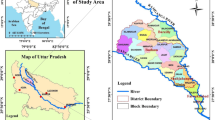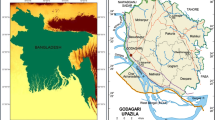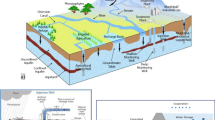Abstract
The Jalna district in the Marathwada region of Maharashtra State, India, represents the south-eastern Deccan Volcanic Province. The district falls under the drought-prone areas programme zone of low rainfall and receives <750 mm annual precipitation from the southwest monsoon. The region has experienced severe droughts for the last couple of decades, which have adversely affected the groundwater levels and yielded potentiality of Deccan Trap basaltic aquifers. As a result, the groundwater resources in the area are under severe stress. Aquifer-wise groundwater management is one of the best solutions to overcome water demand. Keeping this in view, the aquifer-wise groundwater management plan, considering the demand and supply management, is formulated for the Jalna district. As supply-side management, a total of 198 percolation tanks and 565 check dams are proposed, which will augment additional groundwater resources to the tune of 56.55 MCM. At the same time, as a part of demand-side management, micro-irrigation techniques in 14 km2 areas of the district have been recommended, saving a total of 7.08 MCM water. Adopting this plan will store 186.53 MCM volume of groundwater and bring an additional 286.97 km2 land area under assured groundwater irrigation by constructing 11,188 dug wells and 1242 borewells. Proposed plan targets maintaining the stage of groundwater development up to 60% to sustain the assured irrigation and protect the groundwater resources of the Jalna district area for future generations.






Similar content being viewed by others
References
Abu-Allaban M, El-Naga A, Mohamed Jaber M and Hammouri N 2015 Water scarcity impact of climate change in semi-arid regions: A case study in Mujib basin Jordan; Arab. J. Geosci. 8 951–959, https://doi.org/10.1007/s12517-014-1266-5.
Afshar A, Tavakoli M A and Khodagholi A 2020 A multi-objective hydro-economic modeling for sustainable groundwater management; Water Resour. Manag. 34 1855–1869, https://doi.org/10.1007/s11269-020-02533-4, 2019.286673.668795 ijedr./10.22059.
Aghase R M 1994 Hydrogeology of Maharashtra; Central Ground Water Board, Central Region, Nagpur, Ministry of Water Resources, Govt. of India, Report No. 597/STT/94, 292p.
Boazar M, Yazdanpanah M and Abdeshahi A 2019 Response to water crisis: How do Iranian farmers think about and intent in relation to switching from rice to less water-dependent crops?; J. Hydrol. 570 523–530, https://doi.org/10.1016/j.jhydrol.2019.01.021.
CGWB 1980 Project report on concept, methodology and findings of the groundwater exploration and resources evaluation studies in the Sina and Man River Basins, Maharashtra; Central Ground Water Board, Central Region, Nagpur, Ministry of Water Resources, Govt. of India, pp. 36–38.
CGWB 1998a Artificial Recharge Project in Orange growing area, Amravati District and Banana Growing area, Jalgaon District Maharashtra; Central Ground Water Board, Central Region, Nagpur, Ministry of Water Resources, Govt. of India, Report No. 837/ARP/1998a, 51p.
CGWB 1998b Ground water exploration in Maharashtra State and UT of Dadra and Nagar Haveli; Central Ground Water Board, Central Region, Nagpur, Ministry of Water Resources, Govt. of India, Nagpur, 294p.
CGWB 2000 Report on master plan for artificial recharge to ground water in Maharashtra; Central Ground Water Board, Central Region, Ministry of Water Resources, Govt. of India, Nagpur, Report No. 995/ARP/2000, pp. 29–41.
CGWB 2012a Report on drilling, construction and commissioning of 88 piezometers in Vidarbha Region, Maharashtra (AAP-2011–2012); Central Ground Water Board, Central Region, Nagpur, Ministry of Water Resources, Govt. of India, Report No. 1690/GWM/2012, 51p.
CGWB 2012b Hydrogeology of Maharashtra; Central Ground Water Board, Central Region, Nagpur, Ministry of Water Resources, Govt. of India, Report No. 1705/STT/2012, 149p.
CGWB 2013 Hydrogeology and ground water development prospects of Vidarbha Region, Maharashtra; Central Ground Water Board, Central Region, Nagpur, Ministry of Water Resources, Govt. of India, 1784/OTH/2013, 87p.
CGWB 2017 Report of the Ground Water Resource Estimation Committee (GEC-2015); Ministry of Water Resources, Govt. of India, 135p.
CGWB 2018 Interim report on aquifer maps and ground water management plans, Jalna District, Maharashtra; Central Ground Water Board, Central Region, Ministry of Water Resources, RD & GR, Govt. of India, Nagpur, Report No. 2169/NQM/2018, 144p.
CGWB 2019 Ground Water Year Book of Maharashtra and Union Territory of Dadra and Nagar Haveli, 2018–2019; Central Ground Water Board, Central Region, Ministry of Jalshakti, Dept of Water Resources, RD & GR, Govt. of India, Nagpur, Report No. 2235/GWM/2019, pp. 6–8.
CGWB and GSDA 2013 Report on dynamic groundwater Resources of Maharashtra as on March 2011; Central Ground Water Board, Central Region, Ministry of Jalshakti, Govt. of India, Nagpur and Groundwater Survey and Development Agency, Govt. of Maharashtra, Pune, 228p.
Dawadi S and Ahmad S 2013 Evaluating the impact of demand-side management on water resources under changing climatic conditions and increasing population; J. Environ. Manag. 114 261–275, https://doi.org/10.1016/j.jenvman.2012.10.015.
Deolankar S B 1980 The Deccan Trap basalt Maharashtra, India – their potential as aquifer; Ground Water 18(5) 434–437.
Deora S and Nanore G 2019 Socio-economic impacts of Doha Model water harvesting structures in Jalna, Maharashtra; J. Agr. Water Manag. 221 141–149.
Dhokarikar B G 1991 Groundwater resource development in basaltic rock terrains of Maharashtra; Water Industry Publication, Pune, 277p.
Duriaswami R A 2005 Dykes as potential groundwater reservoirs in semi-arid areas of Sakri Taluka, Dhule district, Maharashtra; Gond. Geol. Mag. 20(1) 1–9.
Dolan F, Lamontagne J, Robert Link R, Hejazi M, Patrick Reed P and Edmonds J 2021 Evaluating the economic impact of water scarcity in a changing world; Nat. Commun. 12 1915, https://doi.org/10.1038/s41467-021-22194-0.
Ghasem L, Bakhshoodeh M and Zibaei M 2019 A system dynamics approach for evaluating the impacts of water demand management policies in Kheirabad River Basin; Iranian J. Agr. Econ. Dev. Res. 51(2) 195–216, https://ijaedr.ut.ac.ir/article_76553.html.
GOI 2011 Report of the working group on rural domestic water and sanitation; Ministry of Drinking Water and Sanitation, Water Resources Department, Government of India.
GoM 2016 Maharashtra Groundwater (Development and Management) Act-2009; Maharashtra Act No. XXVI of 2013, Government of Maharashtra, pp. 7–8.
Jankar P D and Kulkarni S S 2013 Watershed Management – a case study of Madgyal village; Int. J. Eng. Res. Tech. 2(7) 1522–1526.
Karanth K R 1999 Groundwater assessment, development and management; Mc-GrawHill, New Delhi, pp. 327–380.
Katpatal Y B, Pophare A M and Lamsoge B R 2014 A groundwater flow model for over-exploited Basaltic Aquifer and Bazada Formation in India; J. Environ. Earth Sci. 72 4413–4425, https://doi.org/10.1007/s12665-014-3342-2.
Khare Y D and Varade A M 2018 Approach to groundwater management towards sustainable development in India; Italian J. Groundwater 308 29–36, https://doi.org/10.7343/as-2018-308.
Lamsoge B R, Katpatal Y B and Pophare A M 2014 Groundwater management using Modflowmodelling; at National Seminar on Groundwater and Lakes at Nagpur; Gondwana Geol. Soc. 14 1–9.
Limaye S D 2010 Review: Groundwater development and management in the Deccan Traps (basalts) of western India; Hydrogeol. J. 18 543–558.
Miraji M, Liu J and Zheng C 2019 The impacts of water demand and its implications for future surface water resource management: The Case of Tanzania’s WamiRuvu Basin (WRB); Water 11(6) 1280, https://doi.org/10.3390/w11061280.
Mohammed W A, Sayyada S B, Quadri N N and Quadri S A 2015 Robust strategies of GIS and geospatial data mining techniques for drinking ground water quality management, challenges and issues of drought case study Jalna (Maharashtra, India); Int. J. Eng. Res. Appl. 5(2) 20–29.
Muller M 2020 Some systems perspectives on demand management during Cape Town’s 2015–2018 water crisis; Int. J. Water Resour. Dev. 36(6) 1054–1072, https://doi.org/10.1080/07900627.2019.1667754.
NRAA 2011 Monitoring and evaluation of artificial recharge of groundwater programmes/ schemes/projects in the rainfed regions of Maharashtra. Study Report-3; National Rainfed Area Authority, New Delhi, India, 151p.
Osman M, Sonune S V, Ravi Shankar K, Dupdal R and Wasre P 2013 Impact evaluation of Kadwanchi Watershed in Maharashtra: Lessons for post-project sustainability; Indian J. Dryland Agric. Res. Dev. 28(2) 9–15.
Ruiz M A, Foster S and Navarro B A 2020 Water-resource stress on the Spanish Costa del Sol: Policy requirements to improve supply security; Water Policy 22(6) 961–971, https://doi.org/10.2166/wp.2020.019.
Saha D, Marwaha S and Dwivedi S N 2020 Chapter 35 - Role of measuring the aquifers for sustainably managing groundwater resource in India; In: Global groundwater, pp. 477–486, https://doi.org/10.1016/B978-0-12-818172-0.00035-9.
Srikantia S V 2008 Watershed development – A route to prosperity in the Darewadi, Ralegaon Siddhi and Hiware Bazar watersheds, Ahmadnagar, District, Maharashtra; J. Geol. Soc. India Memoir, No. 70195-212.
Varade A M, Khare Y D, Mondal N C, Muley S, Wankawar P and Raut P 2013 Identification of water conservation sites in a watershed (WRJ-2) of Nagpur district, Maharashtra using geographical information system (GIS) technique; J. India Soc. Rem. Sens. 41(3) 619–630, https://doi.org/10.1007/s12524-012-0232-5.
Varade A M, Khare Y D, Yadav P, Doad A P, Das S, Kanetkar M and Golekar R B 2018 Lineaments’ the potential groundwater zones in hard rock area: A case study of Basaltic Terrain of WGKKC-2 Watershed from Kalmeswar Tehsil of Nagpur District, Central India; J. Indian. Soc. Remote Sens. 46(4) 539–549, https://doi.org/10.1007/s12524-017-0716-4.
Varade A M, Wadwekar M, Kolte D, Dongre K P and Khare Y D 2011a Appraisal of groundwater situation in and around Nagpur city of Maharashtra, using integrated approach of remote sensing and GIS; Gond. Geol. Magz.; Spl. Vol. 26(2) 129–138.
Varade A M, Wath P, Dongre K P, Khare Y D and Khandare H 2011b Integrated approach using remote sensing and GIS for assessment of groundwater situation in parts of Chandrapur and Gadchiroli Districts of Maharashtra; J. Ind. Geophys. Union 15(4) 195–206.
Wang H, Bracciano D and Asefa T 2020 Evaluation of water saving potential for short-term water demand management; Water Resour. Manag. 34 3317–3330, https://doi.org/10.1007/s11269-020-02615-3.
Acknowledgements
This work is a part of the ‘National Aquifer Mapping and Management (NAQUIM)’ Programme of Central Ground Water Board, Ministry of Jalshakti, DoWR, RD and GR, Govt. of India. The authors are thankful to the Chairman, CGWB, Faridabad, and Regional Director, CGWB, Nagpur, for allowing to compile and publish the work. Thanks to Dr P K Jain for his valuable guidance during the NAQUIM Program. Thanks to Kartik Dongre, Sandeep Waghmare and other Officers of the NAQUIM Program for their contribution during the fieldwork. Also, thanks to all the crew members of drilling rig units, Division-VI, CGWB, Nagpur, engaged during the drilling operations.
Author information
Authors and Affiliations
Contributions
Bhushan R Lamsoge, Anu V, Verma J R, Venkatesam V: Conception and design of the study, NAQUIM project planning and execution, methodology adoption, fieldwork and acquisition of data. Bhushan R Lamsoge, Verma J R and Anu V: Analysis and interpretation of data, preparation of GIS maps and formulation of Aquifer Management Plan. Bhushan R Lamsoge and Abhay M Varade: Drafting and revising the manuscript critically for important intellectual content.
Corresponding author
Additional information
Communicated by Abhijit Mukherjee
Rights and permissions
About this article
Cite this article
Lamsoge, B.R., Varade, A.M., Verma, J.R. et al. Sustainable aquifer management plan for basaltic aquifer system of Jalna district, Maharashtra, India. J Earth Syst Sci 131, 250 (2022). https://doi.org/10.1007/s12040-022-01992-0
Received:
Revised:
Accepted:
Published:
DOI: https://doi.org/10.1007/s12040-022-01992-0




